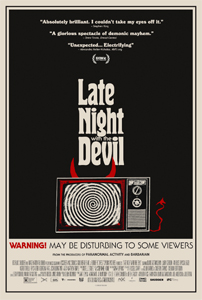“Late Night with the Devil” (Shudder) has a gripping, grindhouse-esque horror concept wherein the supernatural perhaps encroaches on live TV in 1977. But Aussie writer-directors Cameron and Colin Cairnes don’t have the courage of their convictions, and the movie ends up a fascinating repackaging of 1970s horror tropes more so than a fully realized story.
The set designers nicely capture a 1970s late-night talk show look, and veteran character actor David Dastmalchian vibes in the centerpiece role as well-liked but professionally and personally troubled host Jack Delroy. “Night Owls” trails Johnny Carson in the ratings and is in danger of being canceled as Jack embarks on a boffo Halloween special.
The show within the movie is as entertaining as a real Halloween special, as we watch it as if it’s an old videotape. Guests include a psychic, a skeptic, and a possessed 13-year-old girl and her surrogate mother/handler. Further spicing things up are tidbits about Jack during commercial breaks and flashbacks to a California redwoods forest cult that worships a demon.
“Late Night with the Devil” (2024)
Directors: Cameron Cairnes, Colin Cairnes
Writers: Colin Cairnes, Cameron Cairnes
Stars: David Dastmalchian, Laura Gordon, Ian Bliss
“Late Night with the Devil” is the very definition of intriguing buildup, and it deserves points for holding my attention. I raptly looked forward to learning what would happen next, and how it all ties in to Jack’s life, and how this one episode of “Night Owls” changes the world.
(SPOILERS FOLLOW.)
Jack’s secrets (Spoilers)
Keeping it from higher marks, the film doesn’t stick the landing. It doesn’t wildly whiff, but Act III manages to be both rote and underexplained. When 13-year-old Lilly (Ingrid Torelli) fully lets the demon in and it kills everyone on the stage in a special-effects extravaganza, it’s not scary, but it is fun to think “What if this really happened?” Verisimilitude comes from the studio audience scrambling for the exits.
The Carines brothers – joining the Philippou brothers (2023’s “Talk to Me”) at the vanguard of fresh Australian horror — don’t fully explain everything. While a lot of 1970s horror films leave things unexplained to their benefit – and that’s likely what the filmmakers are trying for here – “Late Night with the Devil” needed more. It’s missing that “Holy crap!” clincher, whereas “Talk to Me” very much has it.
As “Late Night” plays with the supernatural and fugue states and hypnotism, we never get a firm sense of whether Jack made a deal with the Devil. The story hints that he did, by noting in sequence his membership in the cult, his rise to showbiz success, and his beautiful wife’s sudden terminal cancer.

But Dastmalchian plays all his scenes as if Jack is stunned by the supernatural events unfolding. Jack never looks guilty, like he might be responsible for some of this; Dastmalchian never looks like he’s acting like he’s acting. The actor captures the 1970s talk-show host flavor, but whiffs on the subtlety needed to complete the portrayal.
The eternal debate (Spoilers)
The in-show debates between the believers and skeptics are enjoyable, if surface-level. Skeptic Carmichael (Ian Bliss) offers a check for $500K to anyone who can prove the existence of the supernatural in a controlled environment. This is a parallel to James Randi’s real-world prize, which he started offering in 1964 at $1,000. It had reached $1 million in 2015 when it was discontinued, with no one completing the challenge in its 50 years.
Since Lilly does get possessed in the controlled environment of the talk-show stage, this event should change the world into an alternate reality from our own. (Most historical fiction slots its events into known reality; for example, “Marvelous Mrs. Maisel” invents a famous comedienne but does not alter the real-world timeline of stand-up comedy. Or alternatively, they explore the changed world; for example, the Monsterverse shows how people have adjusted to the existence of monsters.)
The fact that “Late Night” doesn’t show this new world where the supernatural has bluntly revealed itself isn’t an egregious flaw. But we can’t help but notice the missing piece since the question of whether we live in a supernatural world or a natural world is a core theme.
“Late Night with the Devil” also could’ve reached another level with more dark comedy – although the idea of cutting to “messages from our sponsors” before a séance with the Devil is certainly amusing – or more shock horror. It’s content to be a 1977 Halloween special that goes nuts in the way we expect. It’s a “What if,” and those are automatically fun, but it’s the most timid of “What ifs.”

